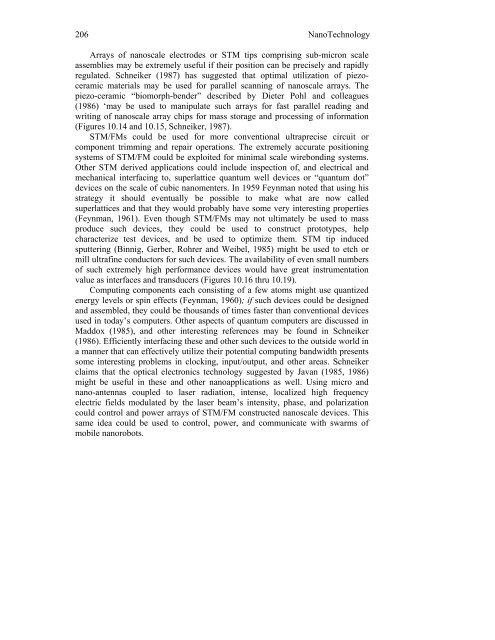ULTIMATE COMPUTING - Quantum Consciousness Studies
ULTIMATE COMPUTING - Quantum Consciousness Studies
ULTIMATE COMPUTING - Quantum Consciousness Studies
- No tags were found...
You also want an ePaper? Increase the reach of your titles
YUMPU automatically turns print PDFs into web optimized ePapers that Google loves.
206 NanoTechnology<br />
Arrays of nanoscale electrodes or STM tips comprising sub-micron scale<br />
assemblies may be extremely useful if their position can be precisely and rapidly<br />
regulated. Schneiker (1987) has suggested that optimal utilization of piezoceramic<br />
materials may be used for parallel scanning of nanoscale arrays. The<br />
piezo-ceramic “biomorph-bender” described by Dieter Pohl and colleagues<br />
(1986) ‘may be used to manipulate such arrays for fast parallel reading and<br />
writing of nanoscale array chips for mass storage and processing of information<br />
(Figures 10.14 and 10.15, Schneiker, 1987).<br />
STM/FMs could be used for more conventional ultraprecise circuit or<br />
component trimming and repair operations. The extremely accurate positioning<br />
systems of STM/FM could be exploited for minimal scale wirebonding systems.<br />
Other STM derived applications could include inspection of, and electrical and<br />
mechanical interfacing to, superlattice quantum well devices or “quantum dot”<br />
devices on the scale of cubic nanomenters. In 1959 Feynman noted that using his<br />
strategy it should eventually be possible to make what are now called<br />
superlattices and that they would probably have some very interesting properties<br />
(Feynman, 1961). Even though STM/FMs may not ultimately be used to mass<br />
produce such devices, they could be used to construct prototypes, help<br />
characterize test devices, and be used to optimize them. STM tip induced<br />
sputtering (Binnig, Gerber, Rohrer and Weibel, 1985) might be used to etch or<br />
mill ultrafine conductors for such devices. The availability of even small numbers<br />
of such extremely high performance devices would have great instrumentation<br />
value as interfaces and transducers (Figures 10.16 thru 10.19).<br />
Computing components each consisting of a few atoms might use quantized<br />
energy levels or spin effects (Feynman, 1960); if such devices could be designed<br />
and assembled, they could be thousands of times faster than conventional devices<br />
used in today’s computers. Other aspects of quantum computers are discussed in<br />
Maddox (1985), and other interesting references may be found in Schneiker<br />
(1986). Efficiently interfacing these and other such devices to the outside world in<br />
a manner that can effectively utilize their potential computing bandwidth presents<br />
some interesting problems in clocking, input/output, and other areas. Schneiker<br />
claims that the optical electronics technology suggested by Javan (1985, 1986)<br />
might be useful in these and other nanoapplications as well. Using micro and<br />
nano-antennas coupled to laser radiation, intense, localized high frequency<br />
electric fields modulated by the laser beam’s intensity, phase, and polarization<br />
could control and power arrays of STM/FM constructed nanoscale devices. This<br />
same idea could be used to control, power, and communicate with swarms of<br />
mobile nanorobots.






